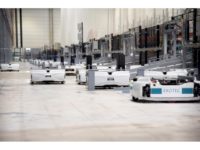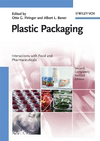As consumers embrace the ease and convenience of buying online, demand for flexible packaging continues to charge ahead at double-digit growth rates. Figuring out how to meet that demand can place considerable strain on warehouse and operations managers trying to find the right mix of human and capital resources needed to keep pace.
At some point in the production cycle, manual labor can become highly inefficient. But, at what volume? And how does seasonality factor into the resource equation? Or, management of material inventory and the supply chain? What about the physical footprint required to achieve required desired throughput levels? And, if you’re able to solve for those variables, how do you optimize the process and end product for sustainability?
The planning matrix can feel like a Rubik’s Cube to an overwhelmed production manager. The answers to the puzzle may be found in the right automation solution, with which companies can increase fulfillment efficiency while maintaining or even enhancing product quality and safety.
Analyze Demand First
To determine if automation is right for you, analyzing production volumes is a great place to start the planning process. When packaging small parcels, for example, it may be time to consider automation once demand surpasses 2,000 packs per day. As daily production output reaches a benchmark of 2,500-3,000 units, the financial equation can dramatically shift in your favor, depending on the type of products being packaged.
Size does matter — a lot. This is particularly true for mass merchants and online retailers whose product mix can vary widely. Smaller products like books, electronic parts, accessories, nutraceuticals, jewelry and other hard goods with lower package profiles often work well with automated systems because of ease in handling. Systems utilizing bubble film provide an extra layer of protection. Surface area dimensions will fluctuate for these products, but, generally speaking, improved efficiency can be attained when package thickness stays within a 3-4 inch range.
Where the most advanced automated systems can deliver their highest value, however, is the ability to right-size packaging. Finding that sweet spot can deliver significant contributions to margin by reducing the dim weights on which courier charges are based. Moreover, a sophisticated automation solution can adjust to these sizing variances on-demand, without expensive time-consuming delays to re-calibrate settings.
Automation That Right-Sizes
Right-sizing represents the new frontier for the evolution of automated packaging. Ultrasonic and fiber optic sensors in systems like PAC Worldwide’s PACJacket are pointing the way forward. The industry’s first automated poly bubble mailer system recognizes varying product profiles and instantaneously uses those data points to produce auto- or fixed-length packages at a throughput rate of 15-20 bags per minute. Besides reducing package void fill, the moisture-resistant packaging also uses co-extruded polyethylene film that is 100 percent recyclable.
While sustainability ranks high with today’s environmentally conscious consumer, labor reduction remains critical with plant managers looking for economies of scale. When evaluating the fully loaded costs of employees for the fulfillment process, the business case for today’s automated systems, especially single-operator, can be compelling.
Consider the math: The average hand-loading speed for a plant floor employee working with protective mailers is roughly two bags a minute, or one every 30 seconds, assuming no breaks in schedule. That translates to 180 bags per hour or 1,260 bags for an eight-hour workday. Compare that to an end-to-end automated solution that can generate anywhere from 900-1200 bags per hour or 6,300-8,400 per shift. That translates to a fulfilment efficiency rate 400-500 percent higher than manual labor.
Determine Space Needs
Productivity is one consideration. Another is the warehouse footprint needed to accommodate that level of production. An automated solution can replace up to five manual pack stations, creating valuable space that can be re-purposed for other uses.
Part of those ergonomic efficiencies can be chalked up to avoiding the need for separate labeling or printing. If the system includes an integrated thermal printing capability, you won’t require a stand-alone Zebra printer — or individual to operate it. The technology now exists to produce repeatable high-quality printing not only on paper, but plastic bubble roll fed through a single web system.
Choices in substrate coating for protective mailers can also factor prominently in your production and financial analysis. Cohesive, cold-seal material performs well in some automated applications, but is non-recyclable, comes with a premium cost and has disadvantages in seal quality. An uncoated substrate that adheres to itself with a heat seal offers a lower material cost and a more consistent seal.
As the time-honored mantra of “better, faster, cheaper” drives innovation in the e-commerce space, automated systems will continue to play a bigger role in fulfillment. When you consider that systems today can generate outputs anywhere from five to seven times faster than a human, the value proposition of automation — particularly in a tight labor market — makes it a solution worth the time and expertise to explore.






